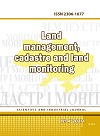On the issue of creatingthe soil of conservation restrictions when using agricultural land
DOI:
https://doi.org/10.31548/zemleustriy2019.04.10Abstract
The article analyzes the current problems of land management for agricultural land use in Ukraine, because fertile land is the basis of civilized human life, and their condition, to a large extent, reflects the health of any nation. Therefore, the intensive exploitation of land to complete exhaustion without the use of improving measures is a complete environmental suicide. Soil is not only the main condition for the existence of human society, but also the most important source of national wealth, a universal factor in any human activity. In agricultural production, land is the main mode of production, without which the process of manufacturing of crop and livestock production is impossible, is both an object and a means of labor, determines not only the pace of development, but also the level of efficiency of agricultural production.
Directions for the formation of soil protection restrictions in the use of agricultural land for lease land use are justified, in particular: agricultural land plots for commercial agricultural production should be used in compliance with the established terms for the return of individual crops in accordance with the permissible types and types of crop rotation according to land management projects, and also landowners and land users in the implementation of ho business activities are obliged to inform the executive authorities and local governments on the quality condition, degradation and pollution of land plots, on the sown area of crops grown on them, with the obligatory registration of the relevant changes in the land cadastre.
Key words: soil protection, land management projects, crop rotation, soil cultivation, restrictions, land use, crop rotation.
References
Dorosh, J.M., Stetsyuk, M.P. (2010) Land management projects that provide ecological and economic justification for crop rotation and land management as a pledge for sustainable land use by agricultural enterprises. The bulletin of the Lviv National Agrarian University. − Lviv, Vol.17 (1). − 92-98. (in Ukrainian)
Krasnolutsky, O., Tikhenko, R., Yevsyukov, T. (2010) Drafting of land management projects that provide ecologically and economically sound crop rotation and land management. Land Management Bulletin. - Kiyv, Vol. 4. − 14−17. (in Ukrainian)
Kustovska, O., Novak, V. (2017) On the issue of creating of corporate structures of agricultural production. Land management, cadastre and land monitoring. - Kiyv, Vol. 3. − 27−33. (in Ukrainian)
Kustovska, O.V., Khvorostenko, O.A. (2015) The importance of soil quality assessment in agricultural production. Formation of market relations in Ukraine. - Kiyv, Vol. 1 (164). − 92−95. (in Ukrainian)
Martin, A.G., Krasnolutskiy, A.V. 2014New Concept of Formation of Soil Protection Restrictions in Agricultural Land Use. Land Management Bulletin. - Kiyv, Vol. 2. − 20−24. URL: http://nbuv.gov.ua/UJRN/Zv_2014_2_9. (in Ukrainian)
Protecting Lands: Law of Ukraine, as of December 18, 2017. URL: https://zakon.rada.gov.ua/laws/show/962-15
On Amendments to Some Legislative Acts of Ukraine on Preserving Soil Fertility: Law of Ukraine, as of December 30, 2011. URL: https://zakon.rada.gov.ua/laws/show/1443-17
Downloads
Additional Files
Published
Issue
Section
License
Relationship between right holders and users shall be governed by the terms of the license Creative Commons Attribution – non-commercial – Distribution On Same Conditions 4.0 international (CC BY-NC-SA 4.0):https://creativecommons.org/licenses/by-nc-sa/4.0/deed.uk
Authors who publish with this journal agree to the following terms:
- Authors retain copyright and grant the journal right of first publication with the work simultaneously licensed under a Creative Commons Attribution License that allows others to share the work with an acknowledgement of the work's authorship and initial publication in this journal.
- Authors are able to enter into separate, additional contractual arrangements for the non-exclusive distribution of the journal's published version of the work (e.g., post it to an institutional repository or publish it in a book), with an acknowledgement of its initial publication in this journal.
- Authors are permitted and encouraged to post their work online (e.g., in institutional repositories or on their website) prior to and during the submission process, as it can lead to productive exchanges, as well as earlier and greater citation of published work (See The Effect of Open Access).


